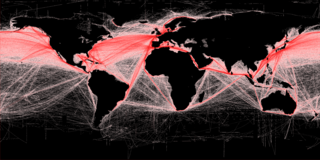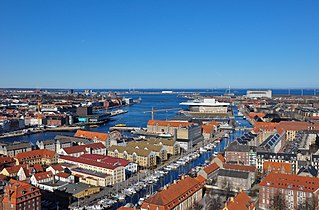Related Research Articles

Freight transport, also referred as freight forwarding, is the physical process of transporting commodities and merchandise goods and cargo. The term shipping originally referred to transport by sea but in American English, it has been extended to refer to transport by land or air as well. "Logistics", a term borrowed from the military environment, is also used in the same sense.

Containerization is a system of intermodal freight transport using intermodal containers. Containerization, also referred as container stuffing or container loading, is the process of unitization of cargoes in exports. Containerization is the predominant form of unitization of export cargoes, as opposed to other systems such as the barge system or palletization. The containers have standardized dimensions. They can be loaded and unloaded, stacked, transported efficiently over long distances, and transferred from one mode of transport to another—container ships, rail transport flatcars, and semi-trailer trucks—without being opened. The handling system is completely mechanized so that all handling is done with cranes and special forklift trucks. All containers are numbered and tracked using computerized systems.

A port is a maritime facility comprising one or more wharves or loading areas, where ships load and discharge cargo and passengers. Although usually situated on a sea coast or estuary, ports can also be found far inland, such as Hamburg, Manchester and Duluth; these access the sea via rivers or canals. Because of their roles as ports of entry for immigrants as well as soldiers in wartime, many port cities have experienced dramatic multi-ethnic and multicultural changes throughout their histories.

An intermodal container, often called a shipping container, is a large standardized container designed and built for intermodal freight transport, meaning these containers can be used across different modes of transport – from ship to rail to truck – without unloading and reloading their cargo. Intermodal containers are primarily used to store and transport materials and products efficiently and securely in the global containerized intermodal freight transport system, but smaller numbers are in regional use as well. These containers are known under a number of names. Based on size alone, up to 95% of intermodal containers comply with ISO standards, and can officially be called ISO containers. Many other names are simply: container, cargo or freight container, shipping, sea or ocean container, container van or sea van, sea can or C can, or MILVAN, SEAVAN, or RO/RO. The also used term CONEX (Box) is technically incorrect carry-over usage of the name of an important predecessor of the international ISO containers, namely the much smaller prior steel CONEX boxes used by the U.S. Army.

A container ship is a cargo ship that carries all of its load in truck-size intermodal containers, in a technique called containerization. Container ships are a common means of commercial intermodal freight transport and now carry most seagoing non-bulk cargo.

Cargo consists of goods conveyed by water, air, or land. In economics, freight is cargo that is transported at a freight rate for commercial gain. Cargo was originally a shipload but now covers all types of freight, including transport by rail, van, truck, or intermodal container. The term cargo is also used in case of goods in the cold-chain, because the perishable inventory is always in transit towards a final end-use, even when it is held in cold storage or other similar climate-controlled facilities. The term freight is commonly used to describe the movements of flows of goods being transported by any mode of transportation.

A cargo ship or freighter is a merchant ship that carries cargo, goods, and materials from one port to another. Thousands of cargo carriers ply the world's seas and oceans each year, handling the bulk of international trade. Cargo ships are usually specially designed for the task, often being equipped with cranes and other mechanisms to load and unload, and come in all sizes. Today, they are almost always built of welded steel, and with some exceptions generally have a life expectancy of 25 to 30 years before being scrapped.

A merchant ship, merchant vessel, trading vessel, or merchantman is a watercraft that transports cargo or carries passengers for hire. This is in contrast to pleasure craft, which are used for personal recreation, and naval ships, which are used for military purposes.

Jurong Port Pte Ltd is a port operator headquartered in Singapore. Jurong Port, which operates the only multi-purpose port in Singapore, handles bulk, break-bulk and containerised cargo. It handled over 40,000 vessel-calls annually in 2019.

CMA CGM S.A. is a French container transportation and shipping company. It is the world’s 3rd largest container shipping company, using 257 shipping routes between 420 ports in 160 countries. Its headquarters are in Marseille, France The name is an acronym of two predecessor companies, Compagnie Maritime d'Affrètement (CMA) and Compagnie Générale Maritime (CGM), which translate as "Maritime Freighting Company" and "General Maritime Company".

Rail freight transport is the use of railroads and trains to transport cargo as opposed to human passengers.

Bulk cargo is commodity cargo that is transported unpackaged in large quantities.
Shipbroking is a financial service, which forms part of the global shipping industry. Shipbrokers are specialist intermediaries/negotiators between shipowners and charterers who use ships to transport cargo, or between buyers and sellers of vessels.

In shipping, break-bulk, breakbulk, or break bulk cargo, also called general cargo, refers to goods that are stowed on board ship in individually counted units. Traditionally, the large numbers of items are recorded on distinct bills of lading that list them by different commodities. This is in contrast to cargo stowed in modern intermodal containers as well as bulk cargo, which goes directly, unpackaged and in large quantities, into a ship's hold(s), measured by volume or weight.

The Port of Copenhagen is the largest Danish seaport and one of the largest ports in the Baltic Sea basin. It extends from Svanemølle Beach in the north to Hvidovre in the south. Along with Malmö harbour, Copenhagen Port is operated by Copenhagen Malmö Port (CMP) and By & Havn.
A shipping container is a container with strength suitable to withstand shipment, storage, and handling. Shipping containers range from large reusable steel boxes used for intermodal shipments to the ubiquitous corrugated boxes. In the context of international shipping trade, "container" or "shipping container" is virtually synonymous with "intermodal freight container", a container designed to be moved from one mode of transport to another without unloading and reloading.

Transport Corporation of India Limited is an Indian logistics and supply chain management company headquartered in Gurugram, Haryana, India. It was founded in 1958 by Mr. Prabhu Dayal Agarwal at Kolkata, India. TCI has 1400+ offices all across India with 6000+ employeess. The whole corporation is composed of eight divisions, namely: TCI Freight, TCI Express, TCI Supply Chain Solution, TCI Global, TCI Seaways and TCI Foundation.

The Red Hook Marine Terminal is an intermodal freight transport facility that includes a container terminal located on the Upper New York Bay in the Port of New York and New Jersey. The maritime facility in Red Hook section of Brooklyn, New York handles container ships and bulk cargo. The Port Authority of New York and New Jersey (PANYNJ) bought the piers in the 1950s when there was still much break bulk cargo activity in the port. The container terminal was built in the 1980s,
A Terminal Operating System, or TOS, is a key part of a supply chain and primarily aims to control the movement and storage of various types of cargo in and around a port or marine terminal. The systems also enables better use of assets, labour and equipment, plan workload, and receive up-to-date information.

The Port of Aarhus is a deep-sea port located in the city of Aarhus. It is the largest container port in Denmark, handling more than 50% of country's container traffic. The Port of Aarhus shipped roughly 8.4 million metric tonnes of cargo in 2017.
References
- ↑ "SKIB72: Godsomsætning på større danske havne efter havn, retning og godsart" (in Danish). Danmarks Statistik. Retrieved 7 August 2015.